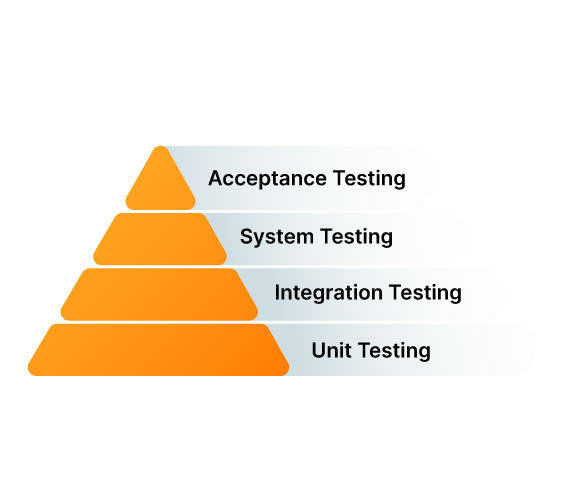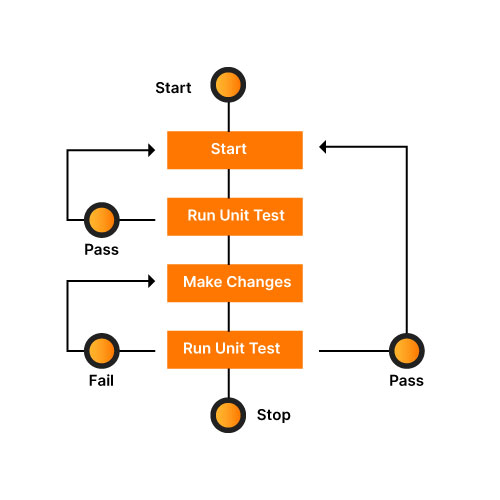Unit tests are great! I mean look at the perks.
They help in regression testing, checking code quality, etc.
But they are often discarded to speed up the SDLC. Often the cost in doing so has been hefty. What if we say that there are best practices that can take care of the issue?
In order to help you with the process, Let’s have a look at some effective Unit Testing Best Practices
What is Unit Testing?
A Unit testing basically covers every small functionality of your software. It verifies the behavior of one component of your software which is independent of other parts.
In Unit Testing there are basically three parts :

- Initialization: An initialized, testable portion of an application is tiny. Typically, the program is referred to as SUT (System Under Test).
- Stimulus: After initialization, a stimulus is applied to the application which is under test. It is usually done by invoking a method that will contain the code to test the functionality of the SUT.
- Result: After the stimulus has been applied to the SUT, then comes the result. This actual result has to be compared with the expected result. If it passes then the functionality is working fine else you need to figure out the problem which is in the system under test.

11 Unit Testing Best Practices
- Tests should be isolated
The test cases have to be separate from one another and they can be organized any way you choose. Apart from this. You can define the cluster – short or long-running test cases. Every test should be orthogonal in such a way that it should be independent of other test cases.
If it weren’t the case, then every modification to the behavior of one test case would have an impact on other tests. This may be accomplished by adhering to the single, uncomplicated rule: “Don’t try to add unnecessary assertions.”
Assertions that correspond to a particular application’s behavior should be included. They shouldn’t rely on any other external elements and should be able to operate independently.
The example tests whether a number can be added with a zero. Multiplication
2. High Speed
Unit tests are an essential part of the software development process, allowing developers to ensure that their application is free of bugs. To achieve this, developers design unit tests in a way that enables repeated execution, effectively catching any potential issues.
However, it is crucial to consider the efficiency of these tests, as slower test execution times can negatively impact the overall test suite. Even a single slow test can significantly increase the time required to run the entire suite of unit tests.
To mitigate this issue, developers should adhere to best coding practices when writing unit tests. By incorporating concepts such as streams into the test code, the execution speed can be improved exponentially.
Therefore, utilizing streams in unit test code is considered a highly beneficial practice. It not only enhances the speed of execution but also contributes to more efficient and effective testing processes.
3. High Readability
For successful communication of the functionality being tested, readability and clarity should be given top priority in unit tests. Each test should outline the situation it is testing and provide a concise tale. If a test fails, the reason why should be obvious, making it easy to find the issue and fix it.
Test cases should be organized logically and simply in order to improve readability. It might be challenging to comprehend and manage tests with complex test cases. So, order and simplicity are crucial.
For both variables and test cases, naming is essential. Each term should appropriately describe the capability and action being evaluated.
Avoid employing meaningless or ornately-sounding names. For instance, a variable or test with the name “Show Logical Exception” doesn’t make it obvious what it performs.
Developers may write unit tests that are simple to understand by following these guidelines, enabling effective debugging and troubleshooting.
4. Good Designing of Tests
Developers may adhere to the following best practices to ensure that unit tests are well-designed:
Single Responsibility Principle: Each test needs to concentrate on a particular action or circumstance. This improves isolation and makes tests easier to read and comprehend.
Use descriptive names for tests and variables to make the purpose and functionality being tested very obvious. This makes the text easier to read and makes it easier to comprehend the exams’ objectives fast.
To minimize cascade failures, test independence should be maintained. Every test need to be autonomous and able to function alone.
Arrange-Act-Assert (AAA) Pattern: Create tests that follow the AAA pattern, which divides the test into three parts: setting up the required preconditions, carrying out the action or operation, and asserting the anticipated result. The readability is improved, and worries are divided.
Test Coverage: To offer thorough coverage, make sure your tests cover a variety of situations, edge cases, and corner cases. This makes the code more resilient and helps in recognizing possible problems.
5. High Reliability
Unit tests are essential for finding problems and guaranteeing the dependability of software systems.
Tests need to ideally only fail when the system is really broken. There are, however, several circumstances in which tests may fail even in the absence of flaws.
It is possible for developers to get into situations where a test runs well on its own but fails when included in a bigger test suite.
Similar unexpected failures could happen when tests are moved to a continuous integration server. These circumstances often point to system design faults.
Minimizing dependence on external elements, such as the environment or certain machine configurations, is crucial for producing high-quality unit tests.
Regardless of the execution environment, unit tests should be created to be independent and consistent. This guarantees that tests get trustworthy results and correctly detect issues.
There may be dependencies or design problems in the codebase if tests repeatedly fail or are sensitive to the execution environment.
The reliability and efficiency of unit tests must be increased by recognizing and fixing these design faults.
Developers may construct strong unit tests that regularly find flaws and provide accurate feedback on the behavior of the system by aiming for test independence and reducing external dependencies.
6. Adopt a Well-organised Test Practice
In order to improve the quality of software development and testing, it is essential to use a well-organized testing procedure.
Significant advancements may be achieved by ensuring that the testing process is in line with software development.
One efficient method is to write test code before production code so that tests may be evaluated while the software is being developed.
This proactive strategy guarantees that tests are in place to confirm the functioning of the code and enables the early detection of any problems.
A well-organized test practice may also be considerably aided by using approaches like test-driven development, mutation testing, or behavior-driven programming.
These methods aid in improving test code quality and encourage a better understanding of the source.
Developers may create a strong and organized testing process that improves the overall quality of the product by adhering to these best practices.
Early defect identification, communication between developers and testers, and complete codebase validation via efficient test coverage are all made possible.
Some effective unit testing good practices that we follow
7. Automates Unit Testing
Though automated unit testing may sound challenging. But it is for no doubt ensures quick feedback, more test coverage, better performance, etc. It in short helps in in-depth testing and gives better results.
8. Focus on a Single Use-Case at a Time
Another good practice of unit test coding is to test a single-use case at one time to verify its behaviors against the expected output.
9. Keep it Unit, Not Integration
Sometimes, we unknowingly shift our focus from unit testing to integration testing. Including more external factors and thus making it difficult to isolate issues and also increasing the production time. And hence we should ensure that unit testing is compulsory unit testing.
Since unit tests concentrate on evaluating distinct pieces of code, it is theoretically feasible to achieve 100% test coverage using just unit tests.
However, aiming for comprehensive coverage in every circumstance may not always be feasible or essential.
Code coverage is a useful indicator, but to guarantee thorough software validation, it should be combined with other testing techniques like manual testing and integration testing.
However, to ensure maximum efficiency,
- Divide the application into more manageable, testable components like classes, functions, or methods. Each unit needs to have a distinct function and be capable of independent testing.
- Create unit tests for each unit that cover various situations and edge cases. Aim to test every potential code path included inside each unit, being sure to exercise all branches and conditions.
- Use test coverage tools or frameworks that can gauge the level of code coverage attained by the tests. These programs provide reports identifying the parts of the code that the tests do not cover.
- Review the code coverage data to find regions of poor coverage. Analyze. Concentrate on building more tests that specifically target those places, making sure to exercise all code paths and eliminate any untested parts.
- If specific sections of the code are challenging to test, think about restructuring those sections to make them more testable. To separate units for testing, remove dependencies, disconnect closely connected components, and use mocking or stubbing approaches.
- Include unit tests in the development process by automatically executing them after every change to the code. This guarantees that any new code additions or updates are checked for coverage right away.
11. Start Using Headless Testing in the Cloud
Conducting automated tests on online applications or software systems without the use of a graphical user interface (GUI) is referred to as “headless testing” in the cloud.
Through direct contact with the underlying code and APIs, headless testing simulates user interactions and verifies functionality.
Headless testing may be carried out in a scalable and distributed way by using cloud infrastructure, enabling the concurrent execution of tests across several virtual computers.
This strategy has advantages including increased testing effectiveness, fewer resource needs, and the capacity to test in many contexts and configurations, improving the general quality and dependability of the program.
Conclusion
Unit tests are mostly considered a burden, especially in a team where team members are working on multiple projects at a time. in this kind of scenario, automation can help a lot. Just make sure that the tests are accessible, maintainable and readable, and self-contained.
Hope you will put our suggestion for unit testing best practices to better use. Together, let’s make sure that quality remains a habit.







